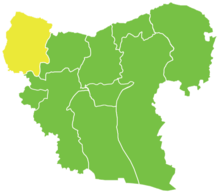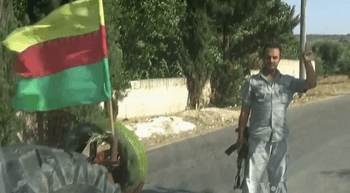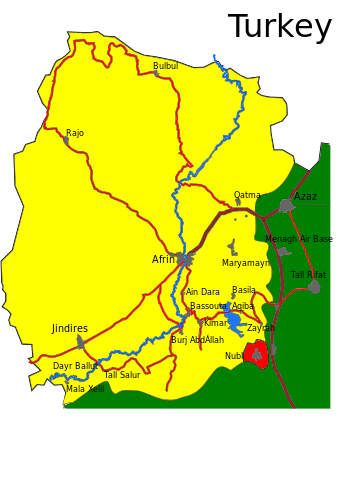Afrin, Syria
| Afrin عفرين Efrîn | |
|---|---|
|
view of Afrin (2009 photograph) | |
 Afrin | |
| Coordinates: 36°30′30″N 36°52′9″E / 36.50833°N 36.86917°E | |
| Country |
|
| Governorate | Aleppo Governorate |
| District | Afrin District |
| Nahiyah | Afrin |
| Elevation | 270 m (890 ft) |
| Population (2004 census)[1] | |
| • Total | 36,562 |
| Time zone | EET (UTC+2) |
| • Summer (DST) | EEST (UTC+3) |
| Website | Official website |
Afrin (Arabic: عفرين / ALA-LC: ʿAfrīn or ʿIfrīn; Kurdish: Efrîn) is a district as well as a town in northern Syria. As a district (mantiqah) of the Syrian Arab Republic, it is part of the Aleppo Governorate. However, since 2012, the Syrian government has lost control of the district, and as the capital of Afrin Canton (Kurdish: Kantona Efrînê) it is now part of the de facto autonomous region of Rojava. The total population of the district as of 2004 was recorded at 172,095 people, of whom 36,562 lived in the town of Afrin itself. The town and district are named for the Afrin River. The town of Afrin is located next to a bridge of the Aleppo road.
History
About 8 km south of the town of Afrin, there are the remains of a Neo-Hittite (Iron Age) settlement known as Tell Ain Dara. The Afrin valley was part of Roman Syria, until it fell to the Arab invasion led by Maslama ibn Abd al-Malik in 711.[2] The Afrin river was known as Oinoparas in the Seleucid era, in the Roman era the name became Ufrenus, whence the Arab vernacular ʿAfrīn, ʿIfrīn, adopted as Kurdish Efrîn.
The area was briefly re-conquered by the Principality of Antioch, but fell again under Muslim rule in 1260 following the Mongol invasions. In the Ottoman period, the area was part of the Kilis Province. Although it is not contiguous with the main area of Kurdish settlement, the Afrin valley seems to have seen Kurdish settlement by at least the 18th century, as by that time it is referred to as the Sancak of the Kurds in Ottoman documents.[3]
With the drawing of the Syria–Turkey border in 1923, Afrin became detached from Kilis Province and was part of French-administrated Syria (i.e. the State of Aleppo, State of Syria (1924–30), Syrian Republic (1930–58)) and was eventually incorporated in modern Syria at the state's formation in 1958/61.
The town of Afrin originated in the 19th-century foundation as a market. In 1929, the number of permanent residents was merely 800, growing to 7,000 by 1968. The town was developed by France under the French mandate of Syria. The main square is Afrin bus station, and the old settlement area stretches northward on the slope of a hill, but more recently habitations have spread to the other side of the river and extend as far to the south-east as the neighboring village of Turandah.
Since the Turkish annexation of Hatay Province in 1939, the Afrin district has been surrounded by the Syria–Turkey border at most of its circumference, apart from the border with the Azaz District to the east and a short border with the Mount Simeon District to the southeast.
There was an outbreak of civil unrest on 21 March 1986, during which three people were killed by the police. In 1999, the arrest of Kurdish leader Abdullah Öcalan triggered renewed clashes between Kurdish protesters and the Syrian police.
During the Syrian civil war, Syrian government forces withdrew from the city during the summer of 2012. The Popular Protection Units (commonly known as YPG) took control of the city soon afterward.[4][5][6]
Afrin district

The district of Afrin is divided into seven sub-districts or Nāḥiyas (population according to 2004 official census):
- Afrin nahiyah (ناحية عفرين): population 66,188.[7]
- Bulbul nahiyah (ناحية بلبل): population 12,573.[8]
- Jindires nahiyah (ناحية جنديرس): population 32,947.[9]
- Rajo nahiyah (ناحية راجو): population 21,955.[10]
- Sharran nahiyah (ناحية شرّان): population 13,632.[11]
- Shaykh al-Hadid nahiyah (ناحية شيخ الحديد): population 13,871.[12]
- Maabatli nahiyah (ناحية معبطلي): population 11,741.[13]
Syrian Kurdistan


Efrin Canton as a de facto autonomous part of Syrian Kurdistan was declared on 29 January 2014.[14][15] The administrative center of Efrîn Canton is the town of Efrîn.[16] The Prime minister of Afrin Canton is Hevi Ibrahim. Most of the people who live in Afrin Canton are Kurds. The local government feels threatened by Nusra Front in the Syrian Civil War.[17]
According to the constitutional Charter of the Social Contract, the Efrîn Canton's Legislative Assembly on its 29 January 2014 session declared autonomy. The assembly elected Hêvî Îbrahîm Mustefa prime minister, who appointed Remzi Şêxmus and Ebdil Hemid Mistefa her deputies. The remaining Executive Council was appointed as follows:[18]
- Foreign Minister: Silêman Ceefer
- Defense Minister: Ebdo Îbrahîm
- Interior Minister: Hesen Beyrem
- Regional Commissions, Councils and Planning Minister: Nûrşan Hisên
- Finance Minister: Remezan Elî
- Labour and Social Security Minister: Erîfe Bekir
- Education Minister: Riyaz Menle Mehemed
- Minister of Agriculture: Eyûb Mihemed
- Health Minister: Xelîl Şêx Hesen
- Economy and Trade Minister: Ehmed Yûsif
- Minister of Martyrs' Families: Ebdilhenan Şêxo
- Culture Minister: Hêvîn Şêxo
- Transport Minister: Welîd Selame
- Youth and Sports Minister: Fazil Robcî
- History and Tourism Minister: Reşîd Ehmed
- Religious Affairs Minister: Mihemed Hemîd Qasim
- Women and Family Minister: Fatme Lekto
- Human Rights Minister: Xelîl Sîno
- Supervision Minister: Etûf Ebdo
- Information Minister: Ebdil Rehman Selman
- Justice Minister: Seîd Esmet Xûbarî
- Energy Minister: Kamîran Ehmed Şefîi Bilal
Climate
Afrin has a hot-summer Mediterranean climate with influences of a continental climate during winter with hot dry summers and cool wet and occasionally snowy winters. The average high temperature in January is 9 and the average high temperature in July is 34. The snow falls usually in January, February or December. Afrin is characterized abundant rain, especially winter, and rainfall ranges between 500 and 600 mm in 1 year, The annual rate of 61% humidity. Afrin suitable to live because of the moderate climate and the large number of olive trees surrounded by.
| Climate data for Afrin | |||||||||||||
|---|---|---|---|---|---|---|---|---|---|---|---|---|---|
| Month | Jan | Feb | Mar | Apr | May | Jun | Jul | Aug | Sep | Oct | Nov | Dec | Year |
| Record high °C (°F) | 18 (64) |
22 (72) |
26 (79) |
35 (95) |
41 (106) |
41 (106) |
43 (109) |
46 (115) |
42 (108) |
38 (100) |
28 (82) |
21 (70) |
46 (115) |
| Average high °C (°F) | 9 (48) |
12 (54) |
16 (61) |
22 (72) |
26 (79) |
29 (84) |
34 (93) |
34 (93) |
28 (82) |
25 (77) |
17 (63) |
11 (52) |
21.9 (71.5) |
| Daily mean °C (°F) | 6 (43) |
8 (46) |
11 (52) |
16 (61) |
20 (68) |
24 (75) |
28 (82) |
28 (82) |
23 (73) |
20 (68) |
13 (55) |
8 (46) |
17.1 (62.6) |
| Average low °C (°F) | 2 (36) |
4 (39) |
7 (45) |
11 (52) |
15 (59) |
19 (66) |
22 (72) |
22 (72) |
18 (64) |
15 (59) |
8 (46) |
4 (39) |
12.3 (54.1) |
| Record low °C (°F) | −11 (12) |
−7 (19) |
−7 (19) |
0 (32) |
6 (43) |
10 (50) |
14 (57) |
11 (52) |
6 (43) |
2 (36) |
−3 (27) |
−6 (21) |
−11 (12) |
| Average precipitation mm (inches) | 110 (4.33) |
85 (3.35) |
60 (2.36) |
40 (1.57) |
30 (1.18) |
10 (0.39) |
0 (0) |
0 (0) |
15 (0.59) |
50 (1.97) |
70 (2.76) |
95 (3.74) |
565 (22.24) |
| Avg. rainy days | 16 | 12 | 10 | 10 | 7 | 3 | 0 | 0 | 3 | 5 | 7 | 15 | 88 |
| Avg. snowy days | 1 | 1 | 0 | 0 | 0 | 0 | 0 | 0 | 0 | 0 | 0 | 1 | 3 |
| Average relative humidity (%) | 84 | 76 | 69 | 65 | 51 | 49 | 41 | 44 | 52 | 56 | 67 | 83 | 61.4 |
| Source: Weather Online, Weather Base, BBC Weather,MyForecast and My Weather 2 | |||||||||||||
References
- ↑ General Census of Population and Housing 2004. Syria Central Bureau of Statistics (CBS). Aleppo Governorate. (Arabic)
- ↑ Andrew Palmer, The Seventh Century in the West-Syrian Chronicles (1993), p. 209, fn. 525.
- ↑ Winter, Stefan (2005). "Les Kurdes du Nord-Ouest syrien et l’État ottoman, 1690-1750". In Afifi, Mohammad. Sociétés rurales ottomanes. Cairo: IFAO. pp. 243–258. ISBN 2724704118.
- ↑ http://www.rudaw.net/english/kurds/4978.html
- ↑ "Liberated Kurdish Cities in Syria Move into Next Phase". Rudaw. 25 July 2012. Retrieved 28 July 2012.
- ↑ "Kurdish muscle flexing". Jerusalem Post. 14 November 2012. Retrieved 14 November 2012.
- ↑ Afrin nahiyah population
- ↑ Bulbul nahiyah population
- ↑ Jindires nahiyah population
- ↑ Rajo nahiyah population
- ↑ Sharran nahiyah population
- ↑ Sheikh al-Hadid nahiyah population
- ↑ Ma'batli nahiyah population
- ↑ "Democratic autonomy has declared in Afrin canton in Rojava". Mednuce. 29 January 2014. Retrieved 23 October 2014.
- ↑ "After Cizîre, Kobanê Canton has been declared". Firat News. Retrieved 23 October 2014.
- ↑ "The Constitution of the Rojava Cantons; Personal Website of Mutlu Civiroglu". civiroglu.net. Retrieved 23 October 2014.
- ↑ "Syria's Kurds Warn Afrin Could Be The New Kobani".
- ↑ ÇİFTE DEVRİM in Özgür Gündem
| Wikimedia Commons has media related to Afrin. |
| |||||||||||||||||||||||||||||||||||||||||||||||||||||||||||||||||||||||||||||||||||||||||||||||||||||||||||||
| |||||||||||||||||||||||||||||||||||||
Coordinates: 36°30′36″N 36°52′04″E / 36.51000°N 36.86778°E


